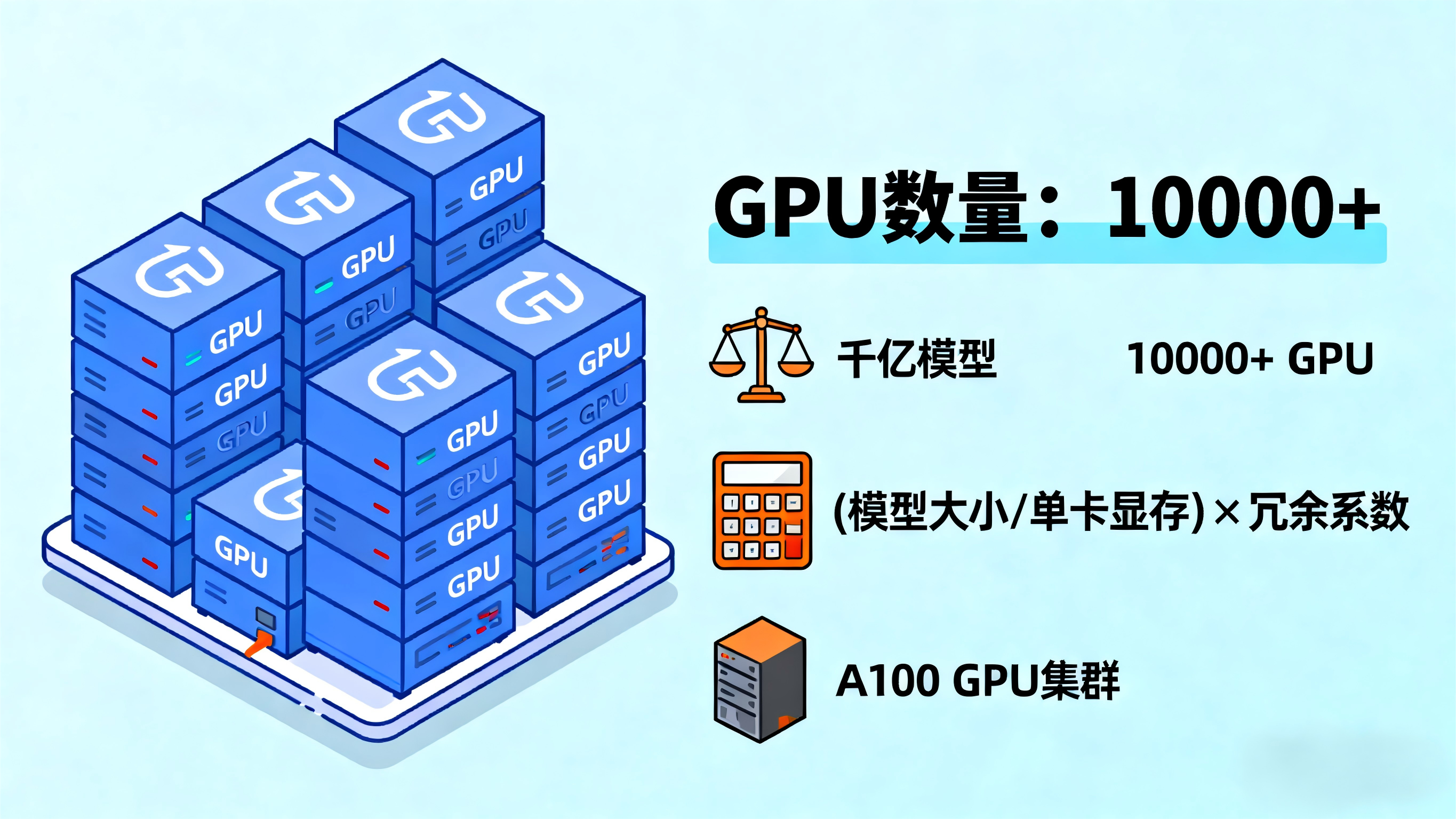大模型的算力需求:训练一个千亿模型需要多少 GPU?
千亿参数大模型训练算力需求分析 本文系统分析了训练千亿参数大模型(如GPT-3、LLaMA 2)的算力需求。关键点包括: 内存需求:FP16精度的千亿参数模型基础存储需200GB,训练时总内存需求达500-700GB,包括参数、梯度、优化器状态和激活值。 计算复杂度:基于DeepMind公式,训练计算量≈6×参数数量×训练tokens,千亿模型训练需约1.8×10^20 FLOPs。 GPU配置:

一、算力需求概述
1.1 千亿参数模型的规模概念
千亿参数模型通常指参数量在1000亿(100B)左右的模型,如GPT-3(175B)、LLaMA 2(70B)等。理解这个规模需要一些直观的对比:
参数量的物理意义:
- 1000亿参数 = 100,000,000,000个浮点数
- FP16精度存储:约200GB显存
- 训练时激活内存:额外需要300-500GB
- 总内存需求:500-700GB
# 千亿参数模型的存储需求计算
def calculate_model_memory(parameters=100e9, precision='fp16'):
"""计算模型参数的内存占用"""
bytes_per_parameter = {
'fp32': 4, # 32位浮点数
'fp16': 2, # 16位浮点数
'bf16': 2, # 脑浮点数16位
'int8': 1 # 8位整数
}
memory_gb = (parameters * bytes_per_parameter[precision]) / (1024**3)
return memory_gb
# 计算基础存储需求
base_memory = calculate_model_memory(100e9, 'fp16')
print(f"千亿参数FP16精度基础存储: {base_memory:.1f} GB")
1.2 算力需求的核心组成
训练千亿模型的总算力需求主要由三部分组成:
总算力需求 = 前向传播计算 + 反向传播计算 + 优化器状态
其中反向传播的计算量通常是前向传播的2-3倍。
二、计算复杂度分析
2.1 FLOPs计算原理
大模型训练的计算复杂度可以用FLOPs(浮点运算次数)来度量:
def estimate_training_flops(parameters, tokens):
"""
估算训练总计算量
根据DeepMind的公式:训练FLOPs ≈ 6 * 参数数量 * 训练tokens
"""
total_flops = 6 * parameters * tokens
return total_flops
# 千亿模型的典型计算量
model_parameters = 100e9 # 1000亿参数
training_tokens = 300e9 # 3000亿tokens(根据Chinchilla定律)
total_training_flops = estimate_training_flops(model_parameters, training_tokens)
print(f"训练总计算量: {total_training_flops:.2e} FLOPs")
2.2 实际计算需求分解
千亿模型训练的计算分解:
- 前向传播:2 * 参数数量 * 序列长度
- 反向传播:4 * 参数数量 * 序列长度
- 优化器状态:额外的内存和计算开销
- 通信开销:分布式训练中的梯度同步
三、GPU需求计算
3.1 内存需求分析
训练千亿模型面临的首要挑战是内存需求:
class MemoryCalculator:
def __init__(self, model_parameters=100e9):
self.model_parameters = model_parameters
def calculate_training_memory(self, batch_size=1, seq_len=2048):
"""计算训练时的总内存需求"""
memory_components = {}
# 1. 模型参数(FP16)
memory_components['model_params'] = self.model_parameters * 2 / (1024**3)
# 2. 梯度(与参数同样大小)
memory_components['gradients'] = self.model_parameters * 2 / (1024**3)
# 3. 优化器状态(Adam优化器:参数、动量、方差)
memory_components['optimizer_states'] = self.model_parameters * 8 / (1024**3)
# 4. 激活值(近似计算)
# 每层激活值 ≈ batch_size * seq_len * hidden_size
hidden_size = 12288 # 典型值
num_layers = 80 # 典型值
activation_memory = batch_size * seq_len * hidden_size * num_layers * 2 / (1024**3)
memory_components['activations'] = activation_memory
# 5. 临时缓冲区等
memory_components['overhead'] = 10 # GB
total_memory = sum(memory_components.values())
return total_memory, memory_components
calculator = MemoryCalculator(100e9)
total_memory, breakdown = calculator.calculate_training_memory()
print(f"训练总内存需求: {total_memory:.1f} GB")
print("内存分布:", breakdown)
3.2 GPU配置方案
基于内存需求,我们可以设计不同的GPU配置方案:
class GPUConfigurations:
def __init__(self):
self.gpu_specs = {
'A100-80GB': {'memory': 80, 'flops': 312e12},
'H100-80GB': {'memory': 80, 'flops': 989e12},
'V100-32GB': {'memory': 32, 'flops': 125e12}
}
def estimate_gpu_requirements(self, total_memory_required):
"""估算需要的GPU数量"""
requirements = {}
for gpu_type, specs in self.gpu_specs.items():
# 基于内存的估算
gpus_by_memory = ceil(total_memory_required / specs['memory'])
# 基于计算效率的调整(考虑并行效率)
efficient_gpus = gpus_by_memory * 1.2 # 20%余量
requirements[gpu_type] = {
'minimum_gpus': gpus_by_memory,
'recommended_gpus': int(efficient_gpus),
'total_memory': gpus_by_memory * specs['memory']
}
return requirements
configs = GPUConfigurations()
gpu_requirements = configs.estimate_gpu_requirements(total_memory)
四、实际训练配置案例
4.1 典型千亿模型训练配置
基于公开的千亿模型训练经验,我们可以总结出典型的硬件配置:
GPT-3 175B训练配置:
- GPU数量:1024张 A100(早期版本)
- 训练时间:约3个月
- 总算力消耗:约3.14e23 FLOPs
- 批大小:3.2M tokens(约1570个序列)
LLaMA 2 70B训练配置:
- GPU数量:2048张 A100
- 训练时间:约21天
- 训练数据:2T tokens
- 优化技术:更高效的并行策略
4.2 分布式训练策略
训练千亿模型必须使用分布式训练,主要并行策略:
class DistributedTrainingConfig:
def __init__(self, total_parameters=100e9):
self.total_parameters = total_parameters
def data_parallel_requirements(self, gpu_memory):
"""数据并行需要的GPU数量"""
# 每个GPU需要存储完整的模型副本
model_memory_gb = self.total_parameters * 2 / (1024**3) # FP16
gpus_needed = ceil(model_memory_gb / gpu_memory)
return gpus_needed
def model_parallel_requirements(self, gpu_memory):
"""模型并行配置"""
# 将模型分层到多个GPU上
layers_per_gpu = 4 # 假设每GPU放4层
hidden_size = 12288
# 计算每层的内存需求
layer_memory = self.calculate_layer_memory(hidden_size)
gpus_needed = ceil(layer_memory * layers_per_gpu / gpu_memory)
return gpus_needed
def pipeline_parallel_requirements(self, sequence_length=2048, batch_size=1):
"""流水线并行配置"""
# 将模型按层分段,不同段放在不同GPU上
# 需要平衡计算和通信开销
optimal_stages = 8 # 经验值
return optimal_stages
def calculate_hybrid_parallelism(self, available_gpus=128):
"""混合并行策略计算"""
config = {
'tensor_parallel': 8, # 8路张量并行
'pipeline_parallel': 4, # 4阶段流水线并行
'data_parallel': 4, # 4路数据并行
'total_gpus': 8 * 4 * 4 # 128张GPU
}
return config
五、成本分析
5.1 硬件成本估算
class CostCalculator:
def __init__(self):
self.hardware_costs = {
'A100-80GB': 15000, # 每张卡价格(美元)
'H100-80GB': 30000,
'DGX_Station': 150000, # 4*A100工作站
'DGX_A100': 200000, # 8*A100服务器
}
self.cloud_costs = {
'A100_cloud_hourly': 10, # 云服务每小时价格
'H100_cloud_hourly': 20,
}
def calculate_training_cost(self, gpu_type, gpu_count, training_days):
"""计算训练总成本"""
if gpu_type in self.hardware_costs:
# 硬件采购成本
hardware_cost = self.hardware_costs[gpu_type] * gpu_count
# 考虑硬件折旧(3年周期)
depreciation = hardware_cost / (3 * 365)
electricity = gpu_count * 0.4 * 24 * training_days # 电力成本
total_cost = depreciation * training_days + electricity
else:
# 云服务成本
hourly_rate = self.cloud_costs.get(gpu_type + '_cloud_hourly', 10)
total_hours = training_days * 24
total_cost = hourly_rate * total_hours * gpu_count
return total_cost
calculator = CostCalculator()
# 示例:使用128张A100训练30天
a100_cost = calculator.calculate_training_cost('A100-80GB', 128, 30)
print(f"128张A100训练30天成本: ${a100_cost:,.0f}")
5.2 不同规模的配置方案
基于实际项目经验,不同预算下的推荐配置:
预算 100万美元:
- GPU数量:64张 A100
- 训练时间:6-9个月
- 适合:70B参数模型
预算 500万美元:
- GPU数量:256张 A100 或 128张 H100
- 训练时间:2-3个月
- 适合:100-200B参数模型
预算 1000万美元:
- GPU数量:512张 H100
- 训练时间:1-2个月
- 适合:200-500B参数模型
六、优化技术与趋势
6.1 减少算力需求的技术
现代训练中采用多种技术来降低算力需求:
混合精度训练:
- FP16/BF16减少内存占用和计算量
- 保持FP32主权重用于精度
梯度检查点:
- 用计算换内存,减少激活值存储
- 典型配置可减少60-70%内存
模型压缩:
- 知识蒸馏
- 参数共享
- 稀疏训练
6.2 新兴硬件的影响
新硬件正在改变算力需求格局:
def compare_hardware_generations():
"""比较不同代际硬件的效率"""
generations = {
'V100': {
'memory': 32, # GB
'flops': 125, # TFLOPS
'efficiency': 1.0 # 基准
},
'A100': {
'memory': 80,
'flops': 312,
'efficiency': 2.5 # 相对于V100
},
'H100': {
'memory': 80,
'flops': 989,
'efficiency': 7.9
}
}
return generations
七、实际建议与决策框架
7.1 GPU数量决策指南
基于项目需求选择合适规模:
class GPURecommendation:
def recommend_configuration(self, budget, timeline, model_size):
"""基于约束推荐GPU配置"""
recommendations = []
# 基于预算的推荐
if budget < 500000: # 50万美元以下
recommendations.append({
'strategy': '云服务 + 小规模',
'gpu_count': 16,
'estimated_time': '6-12个月',
'cost': f'${budget:,.0f}'
})
elif budget < 2000000: # 200万美元以下
recommendations.append({
'strategy': '混合采购 + 云服务',
'gpu_count': 64,
'estimated_time': '3-6个月',
'cost': f'${budget:,.0f}'
})
else: # 200万美元以上
recommendations.append({
'strategy': '大规模集群',
'gpu_count': 256,
'estimated_time': '1-3个月',
'cost': f'${budget:,.0f}'
})
return recommendations
7.2 实际部署考虑
基础设施需求:
- 网络:至少100Gbps InfiniBand
- 存储:高速并行文件系统
- 电力:每机柜20-40kW
- 冷却:液冷或高效风冷
团队要求:
- 分布式训练专家
- MLOps工程师
- 系统管理员
- 领域专家
八、未来趋势
8.1 算力需求演进
大模型训练的算力需求仍在快速增长:
- 2018年:GPT-1,1.17B参数,数十张GPU
- 2020年:GPT-3,175B参数,千张GPU
- 2023年:万亿参数模型,数千张GPU
- 2025年(预测):十万亿参数,万张GPU级别
8.2 技术发展方向
硬件创新:
- 专用AI芯片
- 光学计算
- 存内计算
算法优化:
- 更高效的模型架构
- 稀疏激活
- 更好的并行策略
结论
训练一个千亿参数模型通常需要128-512张现代GPU(如A100/H100),具体数量取决于:
- 模型架构:参数数量、层数、隐藏维度
- 训练策略:并行方式、批大小、序列长度
- 硬件配置:单卡内存、互联带宽
- 时间预算:训练时长要求
- 资金预算:硬件采购或云服务成本
对于大多数组织,建议从云服务开始,逐步积累经验后再考虑硬件投资。随着技术发展,训练效率正在快速提升,但算力需求仍然是进入大模型领域的主要门槛。
更多推荐
 已为社区贡献9条内容
已为社区贡献9条内容







所有评论(0)